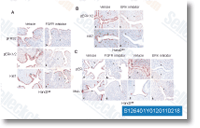Taken collectively, these success advised that the inhibitory effect of matairesi nol on osteoclast differentiation could arise from its possible to inhibit the expression of NFATc1, the key major transcription component required for osteoclast differentiation. Overexpression of NFATc1 restores matairesinol mediated inhibition of osteoclast differentiation To investigate no matter whether suppression of NFATc1 expres sion is crucial for that anti osteoclastogenic activity of matairesinol, the effect of NFATc1 overexpression on matairesinol mediated inhibition of osteoclast differenti ation was evaluated. When BMMs were infected with retrovirus harboring the handle GFP or perhaps a constitutively lively NFATc1 GFP gene expression construct, the infection yield did not differ in between BMMs with all the manage GFP and those with CA NFATc1 GFP.
Constant with all the outcome shown in Figure 1B, the TRAP positive multinucleated osteoclasts have been much less formed from the presence of matairesinol, but the forced expression of NFATc1 significantly overcame the anti osteoclastogenic action of matairesinol. The restoring result of NFATc1 overexpression around the matairesinol induced inhibition of osteoclast differenti ation was also confirmed selleck chemical CP-690550 by counting the number of multinucleated osteoclasts and measuring the activity of TRAP. Taken with each other, these final results con firmed our hypothesis that matairesinol could inhibit RANKL induced osteoclast differentiation by suppressing the expression of NFATc1. Matairesinol inhibits RANKL induced phosphorylation of p38 and ERK To elucidate the mode of anti osteoclastogenic action of matairesinol, we investigated whether or not matairesinol can affect the activation of RANKL induced early signaling pathways.
As proven in Figure 4, RANKL strongly in duced the phosphorylation of p38 and ERK, but mataire sinol radically inhibited these inductions. Our effects propose that inhibition of p38 and ERK phosphorylation could inhibitor b-AP15 contribute to your anti osteoclastogenic action of matairesinol. Matairesinol has no effect on survival and resorptive activity of mature osteoclasts To investigate regardless of whether matairesinol can have an impact on the sur vival and resorptive exercise of mature osteoclasts, we performed both cell counting and the pit formation assay with purified mature osteoclasts from the presence or absence of matairesinol.
When purified mature osteo clasts from co culture were re plated on carbonate apatite coated plates and cultured inside the presence or ab sence of matairesinol for one day, matairesinol did not show any cytotoxicity and didn’t have an effect on the amount of TRAP constructive multinucleated cells. More additional,  the addition of matairesinol did not considerably alter the resorptive exercise of mature osteoclasts, matairesinol treated osteoclasts resorbed the carbonate apatite coated plates similarly to untreated control oste oclasts.
the addition of matairesinol did not considerably alter the resorptive exercise of mature osteoclasts, matairesinol treated osteoclasts resorbed the carbonate apatite coated plates similarly to untreated control oste oclasts.
Taken collectively, these results suggested the inhibitory result
No comments:
Post a Comment